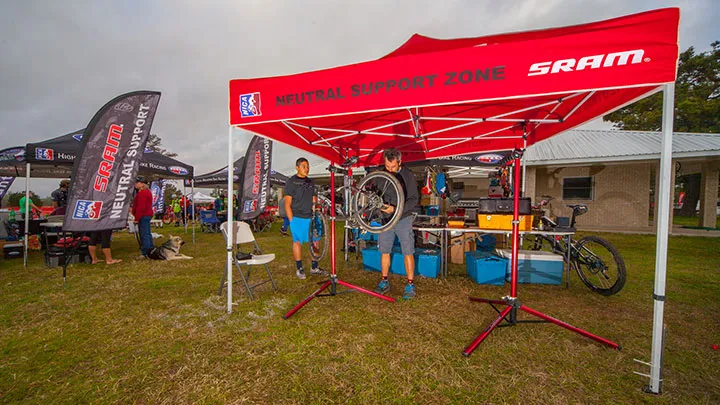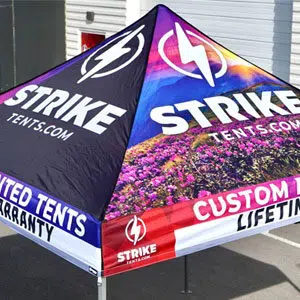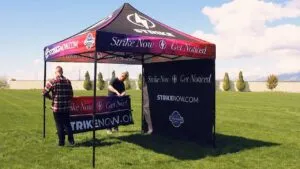Recently updated on April 16th, 2025
It’s simple to stake your favorite canopy tent into the grass. However, to prevent the canopy from blowing away, you will need to figure out how to hold down canopy tent on concrete if you must install it on concrete. The good news is that there are several ways to make low-cost, do-it-yourself weights for your tent. In this section, we learn the ways how to hold down a canopy tent on concrete.
Ways How To Hold Down Canopy Tent On Concrete
It might be challenging to stake a canopy tent on concrete since it cannot be staked into the ground like it can on grass or soil. Here are several ways on how to hold down a canopy tent on concrete:
Bucket Weights
To add weight, lay the buckets on the canopy legs after filling them with sand or gravel. To keep them from moving, fasten them firmly to the tent legs. It is bulky to move and put up, but it is easily adjustable and the materials are easy to find.
Concrete Weights Or Blocks
It is a big pavers or chunks of concrete. To keep the tent in place, place these bulky objects on its legs. You can secure the blocks to the tent legs with a rope or bungee cord for further safety. Every tent leg should have a single weight at its base. Although the components are readily available and work quite well on concrete, they can be heavy and challenging to move.
Heavy-Duty Tent Stakes
You can purchase sturdy stakes that screw into the concrete, or you can use special tent stakes made for use with concrete anchors. To keep the tent in place, these stakes can be anchored with strong anchor bolts or hammered into the concrete. Make holes in the concrete using a hammer drill, then secure the tent’s legs with pegs or anchors. Although it requires drilling and has the potential to fracture concrete, it is extremely safe and efficient.
Large Water Containers
You will need large water containers, such as barrels or jugs. To add weight, fill huge containers with water and set them on each corner of the tent. Put a single container at each leg’s base. Water containers might be large and heavy when filled, but they are rather simple and affordable, especially if you live close to a water supply.
Sandbags
Sandbags: these can be bought or filled with sand. Each leg of the tent can be weighted with sandbags. For extra stability, you can stack many sandbags on top of one another. Put a sandbag on the tent’s legs or corners. Although it is portable, flexible, and may be filled on-site, it must be filled with sand on-site and may need extra fastenings.
Tie-Down Straps
You need strong tie-down straps. Secure the straps around the legs of the tent by tying them to heavy, immobile items in the area, such as lampposts, parking meters, or other fixed structures. Securely fasten the strap’s two ends to the fixed object and the tent leg, respectively. It works well for extra reinforcement, but it needs to be tied down to surrounding structural buildings.
Weight Bags
Weight bags made specifically for canopy tents, usually filled with water or sand. For stability, these bags are fastened to the tent’s legs. For more weight, you can fill them with pebbles, water, or sand. Place them on each of the tent’s four corners, or more if it’s larger. It is simple to assemble and move, however carrying the weight sacks around calls for additional equipment.
Tips For Canopy Extra Stability
Especially when it’s windy or on concrete, the following extra stability tips will help your canopy tent stay stable:
1. Anchor All Tent Legs
Make sure the tent’s four (or more) legs are securely fastened. The tent will be far more durable with equal weight distribution throughout, even if some sides appear to be more wind-sheltered. For extra support, attach extra tie-downs or ropes to each leg and secure them to stationary objects (such as lampposts, large furniture, or a nearby wall).
2. Choose The Right Spot
Set up the tent where there is little chance of wind. Don’t go near open areas or places with lots of wind channels, such as alleyways, towering buildings, or cliffs. Make sure there is level ground beneath your tent. One side of the tent may droop or collapse due to instability caused by uneven surfaces.
3. Secure To Nearby Structures
Securely fasten your tent to any adjacent structures, trees, or poles. To prevent the canopy from swinging or being pushed by the wind, use sturdy ropes or tie-down straps. For an anchor, look for something stationary, such as a light post or fence. By doing this, the tent will be stabilized and less likely to move or lift off the ground.
4. Use Corner Bracing
Consider installing corner bracing for larger tents. This entails fastening ropes from the upper corners to extra anchor points or a stationary object. It will increase wind resistance and stop lateral movement. Cross-brace the canopy with diagonal guy ropes to provide additional structural support.
5. Use Concrete Anchors With Tent Stakes
Use sturdy tent stakes or concrete-specific anchor bolts if you can drill into the concrete (and it’s permitted). These offer a very strong support for your canopy and can be drilled into the ground.
6. Use Heavy Weights
The tent will be more sturdy the more weight you put on each leg. Think about utilizing heavy-duty weight sacks, concrete blocks, or sandbags. Try to get at least 20 to 40 pounds each leg, or more if it’s windy. For further security, use several weight bags or blocks on each leg. This lessens the chance of tipping and helps balance the weight.
7. Use Sturdy Tent Frame
Choose a strong, long-lasting frame that can withstand the wind load, such as one made of aluminum or steel. A sturdy frame will make a tent more resilient to tipping and more able to withstand strain.
8. Use Wind Barriers
If high winds are predicted, use tarps, fences, or even big furniture or equipment to create wind barriers around the canopy. This will provide the canopy with more support and divert the wind away from it.
Conclusion
There are many ways how to hold down a canopy tent on concrete. To secure a canopy tent on concrete, use weight bags, concrete blocks, sandbags, heavy-duty stakes with concrete anchors, tie-down straps, ballast water containers, and bucket weights. These methods require additional equipment for transporting and can be cumbersome. Heavy-duty stakes require drilling and may cause damage to concrete. Tie-down straps and bulky buckets provide extra reinforcement. For extra stability, use heavy-duty weights, anchor all legs, corner bracing, secure to nearby structures, and use wind barriers. A sturdy frame made from steel or aluminum is recommended for better wind resistance.








